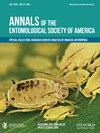梨木虱的多样性、生物学和管理:全球视野
IF 1.8
3区 农林科学
Q1 ENTOMOLOGY
引用次数: 0
摘要
梨木果(Cacopsylla Ossiannilsson;半翅目:木虱总科:木虱科)是一个分类学上困难的类群,至少有24种原产于古北地区。一个或多个品种出现在大多数梨种植区,在某些情况下作为入侵引种。现有的评论主要是分类学的焦点与有限的概述生物学。最早对梨木虱的生物学研究集中在几个西欧物种的核心群体上。在某种程度上,这种关注的出现是因为人们对梨木虱的多样性知之甚少。在过去的30年里,随着分类学认识的进步,分类学研究也在不断扩大。控制梨木虱的难度越来越大,也促进了研究的增长。在这里,我们回顾了现在广泛的关于梨木虱的多样性,生物学和管理的文献。从这一综合中产生了三个广泛的观察结果。首先,对梨木虱的生物学认识在几个地理动物群中仍然存在很大的差距,特别是在古北东部地区的木虱。第二,分类多样性伴随着生物多样性。尽管梨木虱寄主利用具有共性,但在生命周期、越冬和其他生物学性状方面存在显著差异。第三,今天用于管理梨木虱的许多工具都存在,因为针对这些害虫的基础研究历史悠久。这些工具包括更高选择性的新型杀虫剂,各种文化和园艺策略,以及在果园中保护天敌的做法。本文章由计算机程序翻译,如有差异,请以英文原文为准。
Diversity, biology, and management of the pear psyllids: a global look
Abstract The pear psyllids (Cacopsylla Ossiannilsson; Hemiptera: Psylloidea: Psyllidae) are a taxonomically difficult group of at least 24 species native to the Palaearctic region. One or more species occur in most pear-growing regions, in some cases as invasive introductions. Existing reviews of this group are primarily of taxonomic focus with limited overviews of biology. The earliest biological studies of the pear psyllids centered on a core group of a few western European species. In part, this focus arose because diversity of the pear psyllids was poorly understood. As taxonomic understanding has advanced over the last 3 decades, research has expanded taxonomically. Increasing difficulties in controlling the pear psyllids additionally has contributed to growth in research. Here, we review a now-extensive literature on diversity, biology, and management of the pear psyllids. Three broad observations emerged from this synthesis. First, large gaps in biological understanding of the pear psyllids persist for several geographic faunas, most notably for psyllids of the Eastern Palaearctic region. Second, taxonomic diversity is accompanied by biological diversity. Despite the commonality in host use among the pear psyllids, with each species being limited to development on Pyrus, striking differences exist among species in life cycles, wintering, and other biological traits. Third, many of the tools being used to manage pear psyllids today are in existence because of the long history of basic research which has targeted these pests. These tools include new insecticides of higher selectivity, various cultural and horticultural tactics, and practices that conserve natural enemies in orchards.
求助全文
通过发布文献求助,成功后即可免费获取论文全文。
去求助
来源期刊
CiteScore
4.90
自引率
0.00%
发文量
25
审稿时长
6-12 weeks
期刊介绍:
The Annals of the Entomological Society of America exists to stimulate interdisciplinary dialogue across the entomological disciplines and to advance cooperative interaction among diverse groups of entomologists. It seeks to attract and publish cutting-edge research, reviews, collections of articles on a common topic of broad interest, and discussion of topics with national or international importance. We especially welcome articles covering developing areas of research, controversial issues or debate, and topics of importance to society. Manuscripts that are primarily reports of new species, methodology, pest management, or the biology of single species generally will be referred to other journals of the ESA. The most important criteria for acceptance are quality of work and breadth of interest to the readership.

 求助内容:
求助内容: 应助结果提醒方式:
应助结果提醒方式:


